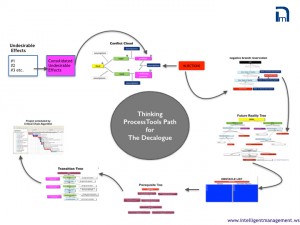
Strategy is about identifying a direction and creating robust solutions to move coherently in that direction. It involves identifying the systemic changes that need to be created.
There are three main phases for this:
- what to change
- what to change to
- how to make the change happen
For each of these phases, there is a powerful Thinking Process Tool from the Theory of Constraints (TOC).
What to change
In the first phase of creating a strategy, we have intuition about the current state of reality that requires change. This intuition can be effectively captured by listing the Undesirable Effects in our current reality. Once identified, these Undesirable Effects can be summarized into a generic Undesirable Effect. This becomes the starting point for building a Core Conflict Cloud diagram. The building of a Core Conflict leads us to identify the profound needs that drive an organization, and these needs are connected with vision and control. Once these needs are precisely verbalized, we can then derive organically the common goal that satisfies those needs. This provides us with a direction upon which to build a coherent strategy, rather than artificially imposing a goal.We then systematically surface all the underlying assumptions (mental models) that connect the statements we have made. Once completed, the Core Conflict Cloud provides us with a root cause analysis of what is keeping us stuck and a clear verbalization of the goal we desire to accomplish with the organization.
What to change to
In this second phase of creating a strategy we identify precise solutions (known as ‘injections’ in TOC) to move us forward towards the goal.We derive these solutions organically by invalidating the assumptions, or mental models, that underlie the Core Conflict we have already verbalized. These injections point in the right direction and make us see where we want to go more clearly. They are the road signs to the future.
Now we need to connect these injections together into a full-blown road map.This is achieved through understanding (analysis/development). Understanding is the human ability to imagine and plan beyond the contingencies of the present and towards a meaningful future. The Thinking Process Tool called the Future Reality Tree (FRT) supports and enhances our understanding. Using a logic of sufficiency, this tool maps out the solutions in a progressive and integrated pattern towards the goal previously identified in the Core Conflict Cloud.
How to make the change happen
At this stage, the Future Reality we desire and the solutions required to achieve it have been meticulously mapped out.We now need to break the solutions down into actionable steps.This is done in two stages. The first stage is completed by building a Prerequisite Tree for every injection in the Future Reality Tree. This Tree is generated by listing all the obstacles that stand between our current situation and the achievement of the injection.These obstacles are then transformed into Intermediate Objectives, and the Intermediate Objectives are mapped out on the basis of which are prerequisites in order to accomplish the Injection.
We can now zoom in further to create steps that can scheduled as a project for every Intermediate Objective. The tool for this is called the Transition Tree (TRT), and it maps out the precise actions to take, as well as the logic behind them. This makes it the ideal tool not just for individuals but for groups to share. It provides a protocol with detailed instructions, and all the elements that allow a project to be built and scheduled. To be continued in next post…
Sign up to our blog here and shift your thinking towards broader, systemic possibilities for yourself and your organization. Intelligent Management provides education and training on systemic management, W. Edwards Deming’s management philosophy and the Theory of Constraints (Decalogue methodology) in North America and Europe.
About the Author
Angela Montgomery Ph.D. is Partner and Co-founder of Intelligent Management and author of the business novel+ website The Human Constraint that has sold in over 20 countries. She is co-author with Dr. Domenico Lepore, founder, and Dr. Giovanni Siepe of ‘Quality, Involvement, Flow: The Systemic Organization’ from CRC Press, New York.





Leave a Reply